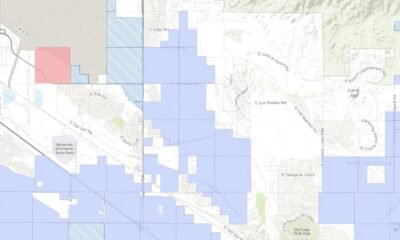Business
Can Desalination End Arizona’s Water Crisis?

There’s long been an idea to use desalination to inject new water into Arizona’s fast-growing population.
ARIZONA, USA — Jeremy Crutchfield twists a silver tap attached to a pipe and places a cup underneath it as the water starts to flow.
“All right,” he says, “Pacific on tap.”
He takes a drink of clear, clean, fresh water that, until an hour ago, had surfers carving through it.
“We’re right by the largest reservoir in the world,” Crutchfield says, surrounded by tanks, pipes and heavy machinery.
The Carlsbad Desalination Plant capitalizes on its position next to that “reservoir,” the Pacific Ocean, to treat billions of gallons of seawater and turn it into usable, drinkable water.
“We’ve produced over 120 billion gallons of high-quality drinking water,” Crutchfield said. “It represents about 10% of the water for San Diego County.”
San Diego County was, and in many ways still is, in a predicament. It’s actually a desert. Very little rain falls there, so water is scarce even though the ocean is within sight.
San Diego has been hit with the same drought the rest of the West and Southwest have dealt with. There were mandatory water use restrictions. The county needed another source of water.
More than a decade ago, officials approved the construction and operation of the Carlsbad Desalination Plant, which was built on the site of an old power plant. The plant had built a large lagoon with a channel to the ocean. The Carlsbad Plant simply built another channel at the other end to let water back into the ocean and set up shop next to it.
The water is pumped from the lagoon to the desalination facility, where it goes through a series of finer and finer filters meant to strain out everything from marine life to sand and dirt and finally, the salt dissolved in the water.
For every two gallons of seawater, the plant produces a gallon of freshwater.
In the final building, Crutchfield stands in the middle of a maze of hoses, pipes and large canisters stacked like firewood to the ceiling. Each canister is a filter, filled with more than 16,000 membranes inside.
So if San Diego can make desalination work for them, could it also work for Arizona?
There’s long been an idea to use desalination to inject new water into Arizona’s fast-growing population.
The Water Infrastructure Finance Authority (WIFA) initially voted to start negotiations on a $5.5 billion desalination plant in Rocky Mount, Mexico.
The initial idea was the build the plant and then run a water pipeline through the desert to Arizona.
An alternative plan would see Arizona help build the desalination plant in Mexico, and then give it to Mexico without the pipeline to Arizona. Mexico would keep the water it produces. In exchange, Arizona would keep the Colorado River water that Mexico is currently entitled to and call it an even trade.
But these plans, and the plant itself, is not without problems.
The first hurdle to desalination is the cost. It’s not cheap to build or operate.
The Carlsbad Desalination plant, along with a ten-mile pipeline needed to connect it to the city water supply, came with a $1 billion price tag.
A pipeline from Mexico to Arizona would be significantly longer, and would also include the costs of pumping water long distances.
The water that comes out of the Carlsbad plant costs $3,400 per acre-foot, which is about the amount of water three households use in a year.
Colorado River water, on the other hand, is about $4,500 per acre-foot.
“It currently is our most expensive supply,” Crutchfield said. “But when you look at alternative water, what new water is out there? There is no cheap water anymore.”
Desalination also comes with an environmental cost, one that various groups have been concerned about for years.
For every two gallons of seawater that’s processed, the desalination plant gives back one gallon of freshwater and one gallon of brine. The salt in the seawater gets concentrated in the leftover gallon of water and pumped back into the ocean.
Environmental groups say that highly salty water can damage marine life and habitat. Officials at the Carlsbad Plant dispute that.
“Building a desalination plant during a water crisis is kind of like shopping when you’re hungry,” Sarah Porter with ASU’s Kyl Center for Water Policy said. “It’s probably a bad idea.”
Porter said desalination is a massive undertaking, one that she’s not even sure we need. Porter said Arizona’s not running out of water any time soon, even with the drought, ongoing negotiations about the future of the Colorado River, and concerns over groundwater depletion.
“You don’t want to build an ocean desal plant until you’re sure that you have a market for that very expensive water,” she said. And right now, Porter doesn’t believe the situation is desperate enough for people to pay for it.
Porter believes there are many more untapped ways to save, conserve and even recycle water that haven’t been tried yet. She worries an Arizona-funded desalination plant might end up being useless.
“We do have examples all around the world including California, including Florida, of big investments in ocean desal plants that wound up being mothballed. “Well, we have one in our own state,” Porter said.
The Yuma Desalting Plant is a poster child for unused desalination in Arizona’s own backyard.
It’s a desalination facility that sits in the Yuma desert near some farmland. It’s a large facility that’s run by the U.S. Reclamation Department. And it hasn’t been run in years.
It was originally built to treat the runoff from Yuma’s farmland. The idea was to remove the impurities from it and use the water again.
It was even tested and run a few times. But in the 30 years it’s been in existence, it’s barely ever been turned on.
“It was built at a time when it seemed like it would be a good solution,” Porter said, “and then it wasn’t needed.”
Instead, the farm runoff collected far downstream in Mexico and created a vibrant — and now protected — wetland habitat. Turning the Yuma plant on again would destroy it.
“You cut off the water supply for one of the last remaining places for our migratory birds,” Porter said.
WIFA, the group that voted to start the ball rolling on a desalination plant in Mexico, has since backed off the idea. The organization voted to see other ideas.
Because of Arizona’s $1.4 billion deficit, lawmakers also voted to strip WIFA of $333 million that was allocated to it.
That was the group’s entire third-year budget, leaving its future uncertain, but the desalination all but dead in the water.


















